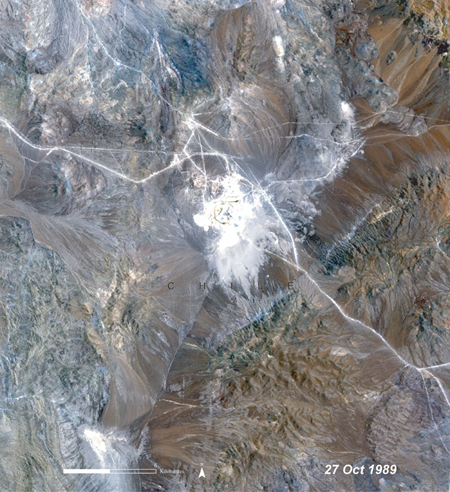Mining
The mining of mineral resources takes place in pits. The resources are gathered above and below ground. When the resources are lying on the surface, the cap rock is carried away in pieces, a cheaper method compared to shaft setting (Latz 2007). An impressive example is the Escondida Mine.
Information to the IR satellite image ↓↑
The infrared satellite image shows the channel combination 4-6-8 (1.65 µm, 2.205 µm, 2.33 µm) in the short-wave infrared. Thereby the different rocks and changes of the mine on the surface can be distinguished (UNEP).
Tasks:
1. Describe the location of the copper mine and its change over time with the help of the satellite images and the text.
2. Read the newspaper articles and examine the economic and ecological consequences of mining.
The Escondida pit
The Escondida pit is located in the midst of the Atacama Desert in northern Chile, approximately 170 km southeast of Antofagasta. It is 3050 metres above sea level and is the biggest copper mine in the world. It is an open-cast mining operation, in which gold and silver are mined, too (UNEP).
Productive operations began in 1990, and since October 2005 the Company also operates Escondida Norte, which is a second open pit located 5 km from the main pit. In 2006, production reached a record of 1,255,599 metric tons of fine copper, representing approximately 8.1% of the world's copper production and 23.4% of Chilean production. The Company mines around 360 million tonnes of mineral annually (MINERA ESCONDIDA SANTIAGO).
Newspaper articles about mining in Chile


Chile's private Escondida copper mine to invest in water↓↑
Northern Chile's lack of water has made it difficult for water-hungry mining operators, who normally must compete with local towns or farming communities for scarce water resources.
But BHP Billiton's private copper-mining company Minera Escondida has come up with a new idea for getting water, a 3.5 billion US Dollar water transport project. The mining company plans to transport sea water from the coast to Chile's northern deserts to supply Escondida's copper mines.
"This project will require the construction of a desalination plant, which will be connected to pipes that transport water to the mines", a Minera Escondida spokesperson told Chilean daily La Tercera.
"We are hoping to increase desalinated water production to 3,200 liters per second (l/s)." In order to fulfill this production goal, the plant would need to have an intake of 7,700 l/s of sea water, meaning that approximately 4,500 l/s of salt water would be left over and redistributed to the ocean through underground emissary tubing.
From the coastal desalination plant, Escondida plans to construct two parallel 180-km aqueducts with the capacity to transport more than half a cubic meter of water per second to the mines.
"We are also contemplating the construction of a 2 million-cubic-meter reservoir at the mining site," the mining spokesperson told La Tercera. "This reservoir would habe the capacity to store and regulate drinking water as well".
(08.09.2008, The Santiago Times)



